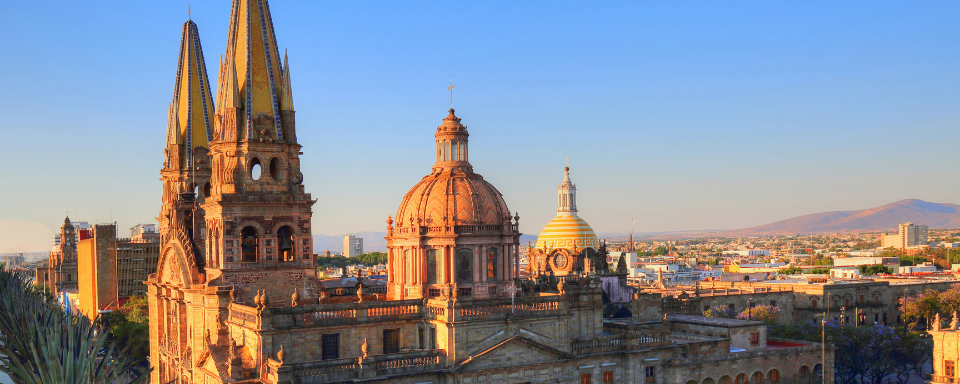
Trade Commissioner Spotlight—Ernesto Miranda Trigueros @ the Embassy of Canada to Mexico
Mexico is the gateway to Latin America and the largest market in the region with over 120 million Spanish speakers, making it the largest Spanish-language market in the world, followed by Colombia and Argentina. The revenue potential from a market that can access more than 490 million Spanish speakers across all continents should not be overlooked.
Later this month, Livres Canada Books is returning to Mexico’s Guadalajara International Book Fair through the support of the Embassy of Canada to Mexico. Our presence in Guadalajara builds on our 2022 Trade Mission to Mexico for Scholarly Publishers at the Feria Internacional del Libro de las Universitarias y de los Universitarios (Filuni) [International Book Fair for Scholarly Books], as well as the connections we have made in this market since 2015.
Among our key partners in the Mexican market are the Embassy of Canada to Mexico and the Trade Commissioner Service, which helps Canadian businesses develop abroad by connecting them with a global network of trade commissioners, international business opportunities, and funding and support programs.
Ahead of our return to FIL Guadalajara, we sat down with the Embassy’s Arts and Creative Industries Trade Commissioner, Ernesto Miranda Trigueros, to ask him about his role at the Embassy, the state of the Mexican book market, and how Canadian publishers can work with the Trade Commissioner Service to help them make inroads or grow their existing business in this major Latin American market.
1. Who are you and what do you do?
I’m Ernesto Miranda and I’ve been working for the creative sector for more than 10 years. I have a background in Spanish and Digital Humanities, and part of my work has been devoted to digital publishing, including interactive editions of renowned Mexican poets and pre-Colombian Códices.
2. Describe the Trade Commissioner services at the Embassy of Canada to Mexico in a few words.
The Arts and Creative industries Trade Commissioner Service in Mexico covers various subsectors within the creative industries. These include audiovisual, creative technology, music, publishing, performing arts, visual and applied arts, as well as museums and heritage. Our main goal is to support and promote business development within these sectors. We aim to generate economic returns for Canadian firms in Mexico while also contributing to the prosperity of Canada. We mostly provide services to Canadian creative companies that are prepared to enter international markets and have a specific interest in the Mexican market.
3. When did you begin working at the Embassy and how has your role changed since then?
I began working for the Embassy in 2019 as a hybrid officer, covering cultural diplomacy and trade promotion for the creative industries, under the mandate of the Trade Commissioner Service.
In 2019, Canada delivered a comprehensive cultural program in Mexico, combining robust cultural diplomacy initiatives and ambitious trade programs to promote Canadian firms. Notably, the mission led by Canadian Heritage in February 2019 to Mexico, Colombia, and Argentina was one of the most ambitious international trade initiatives seen in Mexico.
Unfortunately, 2020 brought us the pandemic, which significantly affected our operations. Despite this, we successfully coordinated dozens of online initiatives, primarily focusing on Indigenous creators from both territories. These initiatives allowed us to share perspectives on the challenges faced during this difficult period. In 2022, we were able to resume our activities, with the renewal of the Creative Export Strategy, placing a stronger emphasis on trade activities to support Canadian companies from the cultural sector that, as we know, were significantly affected during the pandemic.
4. What cultural industry do you engage with the most through the Embassy?
We have observed a growing demand for immersive experiences, a sector that holds great relevance in Canada. Additionally, there is a high demand for performing arts, and Canada has a strong footprint in Latin America’s theater and contemporary dance communities.
We also support at least one yearly activity for the book publishing sector, in collaboration with Livres Canada Books.
5. What is the biggest project you have worked on in this role?
The biggest project I have recently worked on was the Festival Internacional Cervantino—one of the largest performing arts festivals in the world, and the most important one in Latin America. During 19 consecutive days, the Festival showcased Canada’s vibrant and diverse arts sector on the stages and streets of the beautiful city of Guanajuato. Along with the official presentations, we put in place “Canada House,” a physical space strategically located in Guanajuato in which more than 40 activities were offered, including concerts, performances, virtual reality exhibitions, artistic residencies, and poetry readings. More than 20,000 festivalgoers from all over Mexico and other countries visited Canada House to get a taste of Canada’s values and culture, and we were able to gather support from 40 local and Canadian organizations.
6. What is the most interesting project you have supported at the Embassy?
The most interesting project I have worked for is Indigenous Crossroads, in 2021. This was a hybrid festival designed to connect Indigenous artists from Canada and Oaxaca, commemorating 200 years of Mexican independence. The project required extensive project management and a horizontal approach to programming and execution, ensuring that Indigenous voices remained at the forefront of the festival. We programmed more than 100 activities including poetry readings, fanzine publications, VR screenings, and virtual workshops. We also put in place a curatorial board, composed of Indigenous representatives from both Canada and Oaxaca, to define the program and the best approach to a hybrid multicultural event in the middle of the pandemic.
7. How important is the cultural sector in Mexico and what role do books play in this sector?
Culture plays a vital role in Mexico, and a deep understanding of the cultural sector is essential for doing business here. The cultural sector stands for a sizable portion of the GDP (3%). Books also have a significant history in Mexico: The country has a rich publishing tradition, with the oldest press on the continent set up in the former colony of New Spain. Landmark institutions like Fondo de Cultura Económica, the largest distributor of Spanish-language books in the region, was founded in Mexico, and today has a large presence across Latin America. Despite this, and the large consumer base of 140 million people, reading rates have not seen significant growth in the past 10 years. This may be due to factors such as the penetration of digital media, book prices, literacy levels, and weak public initiatives to promote reading.
8. What is the most important thing for Canadian publishers to keep in mind when working in Mexico’s book market? How should they tailor their marketing strategies to this market?
Canadian publishers should keep the following in mind when doing business in Mexico: maintaining constant communication with stakeholders, staying engaged in conversations, and being prepared for delays. The publishing sector is very professional in Mexico, with a a very long and important tradition, but engaging with international stakeholders is sometimes cumbersome for mid-size publishing houses.
Publishers should be very conscious of the diverse cultural communities that live in Mexico and have a segmented and targeted strategy for marketing purposes. Demographics should also be considered, specifically for Young Adult literature.
9. Looking ahead, can you identify a significant opportunity for publishers looking to establish business relations and export their books to this market?
I’d like to encourage Canadian publishers to start seeing Mexico as a growing market for selling books in English and French. Demographics have been changing rapidly since the pandemic, and we are seeing new Anglo- and Francophone communities growing across Mexico. Mexico City, Merida, Oaxaca, Los Cabos, Riviera Maya, San Miguel de Allende, and Chapala are some of the cities that keep growing as hubs for ex-pats, and there may be new potential opportunities there due to an increased demand for books on contemporary issues.

